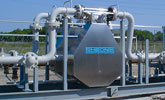Meters capable of up to 1 500 000 kg/hour
May 2007
Flow Measurement & Control

The Coriolis effect was discovered by physicist Gustave Gaspard Coriolis during the 1830s, and is described as "the inertial force exerted on an object as a result of movement relative to a rotating frame of reference". The use of the Coriolis effect as a technique for liquid and gas mass flow measurement was firmly established over 20 years ago.
The Rheonik range of Coriolis mass flowmeters is characterised by its unique and patented Omega tube element which has a torsional or swinging movement rather than the bending motion traditionally associated with Coriolis meters. The torsional motion of the Omega tube is relatively easy to stimulate and requires only a small amount of energy to keep the tubes moving. Rheonik claim that the unique mechanical arrangement of the Omega tube meter allows the use of tubing with heavier wall thickness giving higher pressure ratings, combating abrasion and erosion and eliminating the requirement for the secondary pressure containment found with conventional designs. The tube thickness usually reaches the same schedule as the process pipeline and meters are manufactured right up to 300 mm line size and capable of a flow rate of 1500 tons per hour. This facilitates custody transfer of large pipe mass-flow utilising direct mass measurement as opposed to the conversion of volumetric readings into a mass value.
The flexibility of the Rheonik range in terms of application is due to the patented mechanical arrangement of the meter. Each flowmeter has two measuring tubes parallel to one another and formed into the unique Omega shape. These oscillate in opposing directions. The oscillating system is driven with two high mass crossbars mounted on vertical torsion rods:
* The high mass crossbars stabilise the torsional movement, either eliminating or greatly reducing interference from external vibration and providing continued, reliable operation with the presence of oscillation dampening factors such as entrained gas bubbles or non-homogeneity in the process stream.
* The torsion rods minimise stress on the tubing, guide the tube movement and help 'energise' the torsional motion. This rugged mechanical arrangement is energy conserving and requires very little power input (typically less than 300 mW) to maintain oscillation amplitude. The design provides for an exceptionally well balanced mechanism that approaches perpetual motion once energised.
These meters achieve a turndown ratio of 50:1 and are available in a wide variety of sizes, from extremely low flows of 0,001 kg/min up to 25 000 kg/min. The physical construction of the meters makes them suitable for applications where excessive process conditions are involved with temperatures as low as
-200°C and in excess of 400°C and pressure up to 890 bar. Approvals include EEXia IIC, EEx de IIC (ATEX and CSA) and Fiscal (OIML R117), and models are available in exotic materials such as hastelloy, monel and tantalum to solve the most challenging applications.
Further reading:
Optimising water quality in a building cooling system
ifm - South Africa
Flow Measurement & Control
A leading company in industrial water management has installed water treatment systems that not only optimise water quality but also help customers to improve their processes, thanks to the new insights and actions that can be generated based on the process data collected.
Read more...
New uncompromisingly simple flowmeter line for processes
Endress+Hauser South Africa
Flow Measurement & Control
The demand for simplicity in commissioning, operation and maintenance in industrial process plants has increased significantly in recent years. The new Proline 10 range of flowmeters from Endress+Hauser meets this requirement without compromise, because simplicity is the top priority.
Read more...
Rotork joins Rockwell Automation’s Technology Partner Programme
Flow Measurement & Control
Rotork has entered into the Rockwell Automation Technology Partner Programme, marking a significant step in expanding the company’s presence within the industrial automation landscape.
Read more...
Loop signature 29: Averaging or surge level control
Editor's Choice Flow Measurement & Control
There are many processes where it is undesirable for the load to suddenly change quickly, for example in the paper industry. Examples of level control have involved reasonably fast tuning. An example of a level loop tuned this way and responding to a step change in setpoint is given.
Read more...
A reliable water supply: The make or break in building metros across South Africa
VEGA Controls SA
Flow Measurement & Control
South Africa’s urban centres encounter substantial water supply challenges. Maintaining stable water infrastructure is essential for the health, economic vitality and well-being of communities.
Read more...
Uncompromising flow rate measurement
Burkert South Africa
Flow Measurement & Control
Bürkert’s FLOWave is a hygienic and safe flow measurement solution with many benefits for pharmaceutical or food production processes.
Read more...
Electromagnetic flow measurement
Siemens South Africa
Flow Measurement & Control
The SITRANS FM electromagnetic flowmeters from Siemens deliver high-precision volume measurement of electrically conductive liquid applications – from water, wastewater and irrigation to hygienic processes and even mining slurries with magnetic particles.
Read more...
ABB unveils next generation of electromagnetic flowmeters
ABB South Africa
Flow Measurement & Control
ABB has launched its latest generation of electromagnetic flowmeters, bringing unmatched accuracy, connectivity and flexibility to industrial and utility applications.
Read more...
Precision measurement for ultra-pure water systems
Flow Measurement & Control
[Sponsored] Ultra-pure water (UPW) is essential in industries where even minor contaminants can impact product quality and process integrity. Anton Paar’s L-Cor Coriolis mass flowmeters provide a highly accurate and hygienic solution by directly measuring the mass of the liquid using the Coriolis effect, ensuring a high level of cleanliness.
Read more...
Inline process solutions for gold mining
Anton Paar
Flow Measurement & Control
[Sponsored]The extraction and processing of gold ore requires precision and efficiency to maximise yield and minimise losses. Automation and continuous monitoring of critical process steps are essential to ensure optimal production. Anton Paar offers advanced inline measurement solutions which enable full automation and real-time monitoring of key steps in gold extraction and processing.
Read more...


